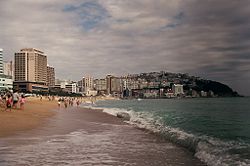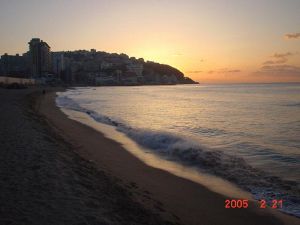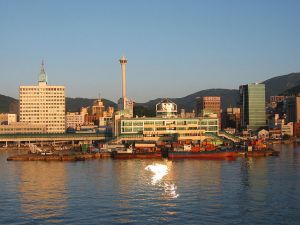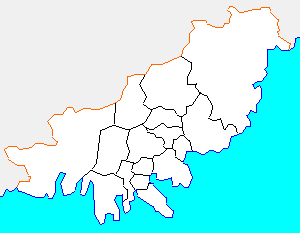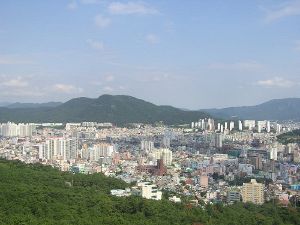Pusan
- "Pusan" redirects here.
| Busan Metropolitan City | |
|---|---|
| Korean name | |
| Revised Romanization | Busan Gwangyeoksi |
| McCune-Reischauer | Pusan Kwangyŏksi |
| Hangul | 부산 광역시 |
| Hanja | 釜山廣域市 |
| Short name | Busan (Pusan; 부산; 釜山) |
| Statistics | |
| Population | 3,635,389 (as of 12.31.2006)[3] |
| Area | 763.46 km² |
| Government | Metropolitan City |
| Administrative divisions | 15 wards (Gu), 1 county (Gun) |
| Region | Yeongnam |
| Dialect | Gyeongsang |
| Location map | |
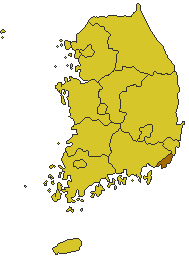
| |
Busan Metropolitan City, also known as Pusan[1] (this is also a correct phonetic variant) is the largest port city in the Republic of Korea. With a population of about 3.65 million, Busan is also South Korea's second largest metropolis, after Seoul. The densely populated city is situated in the narrow Nakdonggang valley, with mountains separating some of the various districts.
Busan was the host city of the 2002 Asian Games and APEC 2005. It was also one of the host cities for the 2002 FIFA World Cup, and is the center for international conventions in Korea. Administratively, it is designated as a Metropolitan City. On November 14, 2005, the city officially announced its bid to host the 2020 Summer Olympics Games.[2]
Places of interest
Geumjeongsan to the west is a popular weekend hiking spot for Busan residents. To the north, the neighborhoods around Pusan National University (also known as PNU, which is one of the most highly recognized national institutes of high education in Korea) have student theaters, cafes, bars and restaurants, as well as open-air cultural street performances on weekend nights. Tongdosa is one of the major three Buddhist temples in Korea. Another temple, Beomeosa, is also very important in Korean Buddhism.
Dongnae area is a traditional as well as wealthy residential area. Dongnae Oncheon is a natural spa area with many baths, tourist hotels, restaurants, clubs and shopping areas. Many restaurants in the area are famous for their family recipes. Chungnyeolsa is a Confucian shrine for soldiers who died during the eighteenth century battle against the Japanese at Dongnae castle.
Busan is the so-called summer capital of Korea since it attracts tourists from all over the country to its six beaches. High class hotels and a carnival boardwalk line the Haeundae Beach district, which is generally regarded as one of the most beautiful beaches in Korea. Gwangalli Beach is famous for its cafes, bars, and restaurants along the beach. The area around Pukyong National University and Kyungsung University has many cafes, bars and restaurants attracting college students and youth.
Seomyeon is recognized as the new downtown with many cafes, bars, restaurants, shops and shopping centers.
The Gwangbok-dong and Nampo-dong areas form the old downtown with many cafes, bars, shops and restaurants. Some of the restaurants in the area are famous with family recipes passed down the generations. Jagalchi Market (near the very active port) is an area of narrow street stalls and is well known for its fish market. Taejongdae, is a natural park with magnificent cliffs facing the open sea on the island of Yeongdo.
The area titled as the "Foreigners' Shopping Street", but commonly referred to as "Texas Street" near the main docks, has many Russian businesses that cater to the local Russian population, as well as the crews of foreign ships. The area was originally known as the Foreigners' Street because many businesses were set up there during the 1940s and 1950s to cater to American soldiers in the area. The Busan-Jinhae Free Economic Zone Authority, one of two such administrations (the other in the harbor of Incheon), was created to continue the tradition of Busan's status as an international trading center. It now attracts ships from all over the globe and aspires to become a regional financial center. Currently, Busan is ranked internationally as the third largest seaport in terms of cargo volume and efficiency by the AAPA.
Busan was one of the few areas in Korea that remained under the control of South Korea throughout the Korean War and for some time it was the capital of South Korea. UN troops established a defensive perimeter around the city known as the Pusan Perimeter in the summer and autumn of 1950. Since then, like Seoul, the city has been an independent metropolis and has built a strong urban character.
Since 1982, the city has been home to the Lotte Giants, who play in the Korean baseball league. In Korea, Busan is known as the capital of baseball and has a reputation for very enthusiastic baseball fans.
The city is also home to K-League soccer side Busan I'park, the Daewoo Unicorns, which was the strongest team during the 1990s in K-league.
Busan is also famous for the Pusan International Film Festival, or PIFF, which is the largest and best-known international film festival in Asia and annually attracts huge numbers of tourists from all over East Asia and the world. Busan also hosts an annual polar bear swimming competition in Haeundae Beach during the winter.
Busan continues to be an important educational, cultural and economic center for the nation. Its beautiful beaches, festivals and glittering nightlife make it a popular destination for many tourists.
Administrative divisions
- Main article: Districts of Busan
In 1957 Busan adopted a division system with the creation of 6 gu: Busanjin-gu, Dong-gu, Dongnae-gu, Jung-gu, Seo-gu, and Yeongdo-gu.
Today, Busan is divided into 15 gu (districts) and 1 gun (county).
- Buk-gu (북구; 北區)
- Busanjin-gu (부산진구; 釜山鎭區)
- Dong-gu (동구; 東區)
- Dongnae-gu (동래구; 東萊區)
- Gangseo-gu (강서구; 江西區)
- Geumjeong-gu (금정구; 金井區)
- Haeundae-gu (해운대구; 海雲臺區)
- Jung-gu (중구; 中區)
- Nam-gu (남구; 南區)
- Saha-gu (사하구; 沙下區)
- Sasang-gu (사상구; 沙上區)
- Seo-gu (서구; 西區)
- Suyeong-gu (수영구; 水營區)
- Yeongdo-gu (영도구; 影島區)
- Yeonje-gu (연제구; 蓮堤區)
- Gijang-gun (기장군; 機張郡)
History
Geochilsan-guk existed in the second and third centuries as a chiefdom of Jinhan. It was absorbed by Silla and renamed Geochilsan-gun. The word Geochilsan means rough mountain, probably referring to Hwangnyeongsan, located at the center of the city.
The grave goods excavated from mounded burials at Bokcheon-dong indicate that a complex chiefdom ruled by powerful individuals was present in the Busan area just as the Three Kingdoms of Korea were forming, c. A.D. 300-400. The mounded burials of Bokcheon-dong were built along the top of a ridge that overlooks a wide area that makes up parts of modern-day Dongnae-gu and Yeonje-gu. Archaeologists excavated more than 250 iron weapons and ingots from Burial No. 38, a wooden chamber tomb at Bokcheon-dong.
In 757, Geochilsan-gun was again renamed Dongnae, which it is still called.
From the beginning of the fifteenth century, the Korean government designated Busan as a trading port with the Japanese and allowed their settlement. Other Japanese settlements in Ulsan and Jinhae diminished later, but the Busan settlement, called Waegwan at the time, continued until Japan invaded Korea in 1592. After the war, diplomatic relations with the new shogunate in Japan were established in 1607, and Busan Waegwan was permitted to be reconstructed. The Japanese settlement, though relocated into Choryang later, continued to exist until Korea was exposed to modern diplomacy in 1876. In 1876, Busan became the first international port in Korea.
During the Japanese occupation, Busan developed into a hub trading port with Japan. Busan was the only city in Korea to adopt the steam tramway before electrification was introduced in 1924. And Busan is the only city in Korea that was never taken by the North Korean Communists during the Korean War. As a result the city was a refugee camp site for Koreans during the war.
Since 1978, Busan has opened three container ports including Jaseungdae, Shinsundae and Gamman. Busan is renowned as one of the world's largest ports and can handle up to 6.44 million TEU shipping containers per year.
Transportation
The Coastal Ferry Terminal (연안여객터미널) serves ferry services to many locations on Geoje Island as well as to Jeju City in Jeju-do.[3]
Ferries leaving from the International Ferry Terminal (국제여객터미널) on Busan Harbor Pier 1 connect Busan to the Japanese ports of Izuhara and Hitakatsu on Tsushima Island, as well as the cities of Shimonoseki, Fukuoka, and Osaka on Japan's mainland.[4]
- PanStar[5] operates the PanStar Ferry between Busan and Osaka.
- The Seaflower 2, the ferry to Tsushima operated by Dae-a Express Shipping,[6] carries passengers only between Busan and Hitakatsu in 1 hour 40 minutes and between Busan and Izuhara in 2 hours 40 minutes.
- The Seonghee, operated by Pukwan Ferry,[7] links Busan to Shimonoseki.
- One of the ferries to Fukuoka is the Camellia, operated by Camellia Line.[8] The Camellia make the trip to Fukuoka over-night in 7 hours 30 minutes, and trip back in the afternoon in 5 hours 30 minutes.
- The other ferry service to Fukuoka is assumed by the Beetles and the Kobees, 2 fleets of high-speed hydrofoils operated by Mirajet.[9] About 5 departures from each cities are scheduled every day. By hydrofoil it only takes 2 hours 55 minutes to cross the Korea Strait to Fukuoka. The Beetles are owned by JR Kyushu.
Busan is served by Gimhae International Airport in the west.
Busan lies on a number of rail lines, of which the most important is the Gyeongbu Line which connects it to other major cities such as Seoul, Daejeon, and Daegu. All classes of trains run along the Gyeongbu Line, including the KTX trains which provide service to Seoul in approximately 150 minutes. The Gyeongbu Line terminates at Busan Station. Other lines include the Donghae Nambu Line.
The Busan Subway network contains three lines: Line number 1, Line number 2, and Line number 3. It's operated by the Busan Transportation Corporation.
Higher education in Busan
Universities with graduate schools
- Pusan National University (PNU)
- Pukyong National University (PKNU)
- Korea Maritime University
- Busan National University of Education
- Dong-A University
- Dong-eui University
- Kyungsung University
- Silla University
- Pusan University of Foreign Studies (PUFS)
- Dongseo University
- Tongmyong University of Information Technology
- Kosin University
- Catholic University of Pusan
- Busan Jangsin University
- Youngsan University
Other institutes of higher education
- Busan Arts College
- Busan College of Information Technology
- Busan Kyungsang College
- Busan Polytechnic College
- Dong-Pusan College
- Dongju College
- Daedong College
- Kyungnam College of Information and Technology
- Pusan Arts College
- Pusan Women's College
- Tongmyong College
Business Organisations
- European Union Chamber of Commerce in Busan
Sister cities
Busan shares the title of sister city with several coastal cities or provinces across the world.[10]
 - Kaohsiung, Taiwan (1966)
- Kaohsiung, Taiwan (1966) - Los Angeles, USA (1967)
- Los Angeles, USA (1967) - Shimonoseki, Japan (1976)
- Shimonoseki, Japan (1976) - Barcelona, Spain (1983)
- Barcelona, Spain (1983) - Rio de Janeiro, Brazil (1985)
- Rio de Janeiro, Brazil (1985) - Fukuoka, Japan (1989)
- Fukuoka, Japan (1989) - Vladivostok, Russia (1992)
- Vladivostok, Russia (1992) - Shanghai, People's Republic of China (1993)
- Shanghai, People's Republic of China (1993) - Surabaya, Indonesia (1994)
- Surabaya, Indonesia (1994) - State of Victoria, Australia (1994)
- State of Victoria, Australia (1994) - Tijuana, Mexico (1995)
- Tijuana, Mexico (1995) - Ho Chi Minh City, Vietnam (1995)
- Ho Chi Minh City, Vietnam (1995) - Auckland, New Zealand (1996)
- Auckland, New Zealand (1996) - Valparaiso, Chile (1999)
- Valparaiso, Chile (1999) - Province of Western Cape, South Africa (2000)
- Province of Western Cape, South Africa (2000) - Montreal, Canada (2000)
- Montreal, Canada (2000) - Istanbul, Turkey (2002)
- Istanbul, Turkey (2002) - Dubai, United Arab Emirates (2006)
- Dubai, United Arab Emirates (2006) - Chicago, USA (2007)
- Chicago, USA (2007)
The Port of Busan also has 6 sister ports.[11]
 - Port of Southhampton, United Kingdom (1978)
- Port of Southhampton, United Kingdom (1978) - Port of Seattle, USA (1981)
- Port of Seattle, USA (1981) - Port of Osaka, Japan (1985) [4]
- Port of Osaka, Japan (1985) [4] - Port of Rotterdam, Netherlands (1985)
- Port of Rotterdam, Netherlands (1985) - Port of New York & New Jersey, USA (1988)
- Port of New York & New Jersey, USA (1988) - Port of Shanghai, China (1994)
- Port of Shanghai, China (1994)
See also
- List of Korea-related topics
- List of cities in South Korea
- Centum City
Notes and references
- ↑ This romanization of the city's name is in McCune-Reischauer. It was used prior to the official adoption of the Revised Romanization by the South Korean Government in 2000.
- ↑ People's Daily Online (2005-11-14). Pusan to declare bid to host 2020 Olympic Games. Retrieved December 8, 2006.
- ↑ (Korean) Coastal Ferry Terminal
- ↑ International Ferry Terminal
- ↑ (Korean) PanStar, Korean operator of the ferry linking to Osaka, Japan.
- ↑ (Korean) Dae-a Express Shipping, operator of the ferry linking to Tsushima Island, Japan.
- ↑ Pukwan Ferry, operator of the ferry linking to Shimonoseki, Japan.
- ↑ (Japanese) Camellia Line, (Korean) Korea Ferry
- ↑ Kobee and Beetle, ferries linking to Fukuoka, Japan.
- ↑ List of Busan's sister cities, Busan Metropolitan City; (English) [1], (Korean) [2]
- ↑ Port of Busan, Sister Ports, Busan
External links
- Busan Metropolitan Government
- Port of Busan
- Tourist Information
- Galbijim wiki page on Busan
- Hotel info
- Map of Busan
- Lotte Giants baseball team
- Pusan International Film Festival
- Pusan National University
Template:Busan
bg:Пусан da:Busan de:Busan et:Pusan es:Busán eo:Pusano fr:Pusan gl:Busan zh-classical:釜山 ko:부산광역시 io:Busan id:Busan it:Busan lv:Pusana lt:Pusanas nl:Busan ja:釜山広域市 no:Busan nn:Pusan pl:Pusan pt:Busan ro:Busan ru:Пусан simple:Busan fi:Busan sv:Pusan th:ปูซาน vi:Busan tr:Busan zh:釜山
Credits
New World Encyclopedia writers and editors rewrote and completed the Wikipedia article in accordance with New World Encyclopedia standards. This article abides by terms of the Creative Commons CC-by-sa 3.0 License (CC-by-sa), which may be used and disseminated with proper attribution. Credit is due under the terms of this license that can reference both the New World Encyclopedia contributors and the selfless volunteer contributors of the Wikimedia Foundation. To cite this article click here for a list of acceptable citing formats.The history of earlier contributions by wikipedians is accessible to researchers here:
The history of this article since it was imported to New World Encyclopedia:
Note: Some restrictions may apply to use of individual images which are separately licensed.
